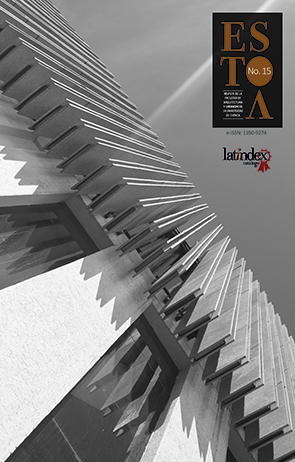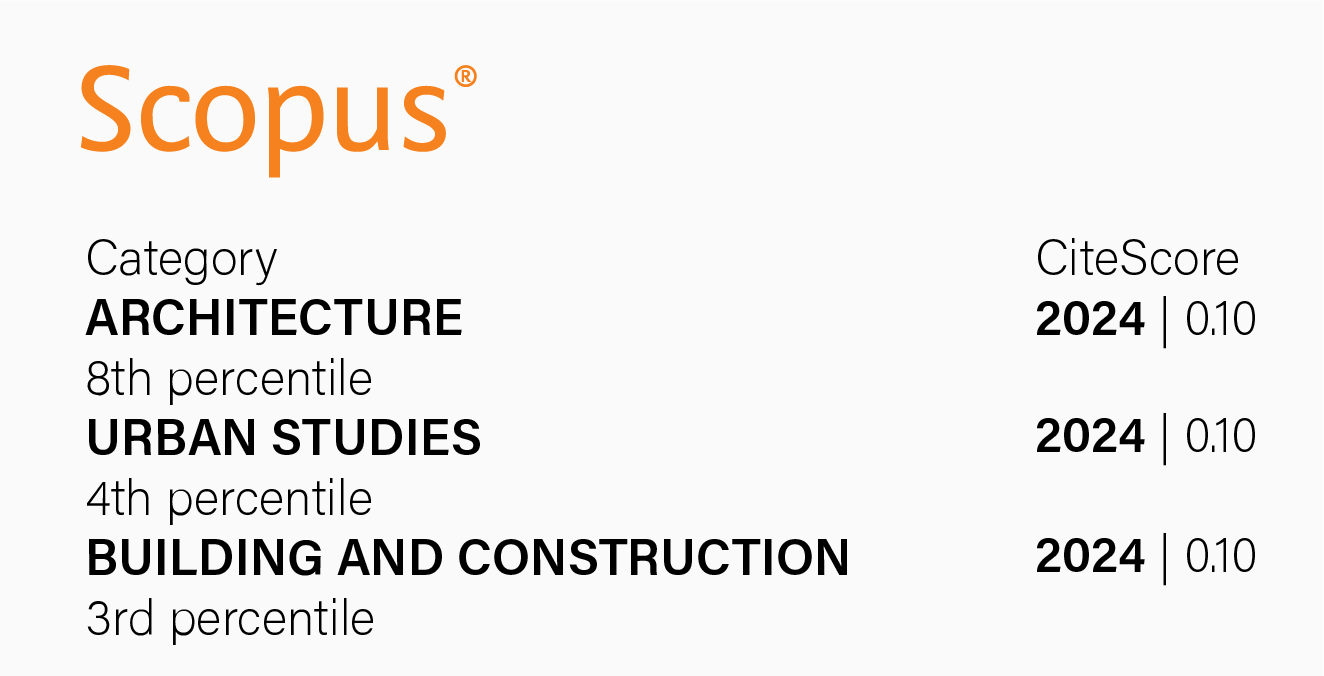Sustainability standards for patrimonial housing in the Historic Center of Cuenca - Ecuador
DOI:
https://doi.org/10.18537/est.v008.n015.a06.Keywords:
Energy efficiency, indoor quality environment, heritage, historic buildings, houseAbstract
The aim of the study is to analyze the standards of energy efficiency and quality of the indoor environment of the heritage dwellings in the Historic Centre of Cuenca, considering the following factors: energy consumption, temperature, indoor air quality, natural lighting and acoustic comfort. The methodology used is mixed and of longitudinal design, involving quantitative and qualitative variables for the evaluation of environmental and electrical measurements, as well as the perceptions of comfort of the occupants of the houses. In a first stage, a survey is carried out to 280 houses in Cuenca to determine energy consumption habits and indoor environment conditions; in a second phase, a monitoring of electrical and environmental variables is carried out in three houses with patrimonial characteristics, through the use of measurement sensors, simulations and perception surveys. Subsequently, the results are analyzed and evaluated in order to compare them with energy efficiency and indoor environment quality standards of national and international standards, determining results that demonstrate that users adapt to comfort conditions different from those established by standards, such as temperature, where users, in response to the Andean climate, admit lower ranges than the established standards.
Downloads
References
ASHRAE 55-2010, S. (2013). Thermal Environment Conditions for Human Occupancy: www.ashrae.org.
ASHRAE 55. (2010). ASHRAE 55-2010: Thermal Environment Conditions for Human Occupancy.
ASHRAE 62.1. (2007). Ventilation for acceptable indoor air quality (Vol. 62.1): ANSI-ASHRAE.
Baquero, M. T. (2016). Eficiencia energética en el sector residencial de la ciudad de Cuenca, Ecuador. Cuenca, Ecuador: Universidad de Cuenca, Facultad de Arquitectura y Urbanismo.
Barr, S., Gilg, A., y Ford, N. (2005). Defining the multi-dimensional aspects of household waste management: A studyof reported behavior in Devon. Resources Conservation & Recycling, 172-192.
Bayulken, B., y Huisingh, D. (2015). Perceived ‘Quality of Life’ in eco-developments and in conventional residential settings: an explorative study. Journal of Cleaner Production, 98, 253-262. doi: 10.1016/j.jclepro.2014.10.096
Brunsgaard, C., Heiselberg, P., Knudstrup, M.-A., y Larsen, T. S. (2012). Evaluation of the Indoor Environment of Comfort Houses: Qualitative and Quantitative Approaches. Indoor and Built Environment, 21(3), 432-451. doi: 10.1177/1420326x11431739
Center for Built Environment, C. (2015). Occupant Indoor Environmental Quality (IEQ) Survey., from www.cbe.berkeley.edu/research/survey
Cuenca ciudad sostenible. Plan de accion: GAD Municipal del cantón Cuenca. (2014). Quito, Ecuador: Banco Interamericano de Desarrollo.
Delgado, D. (2016). Balance Energético Nacional 2016: Año Base 2015 (p. 118). Ecuador: Ministerio Coordinador de Sectores Estratégicos.
Dili, A. S., Naseer, M. A., y Varghese, T. Z. (2010). Passive environment control system of Kerala vernacular residential architecture for a comfortable indoor environment: A qualitative and quantitative analyses. Energy and Buildings, 42(6), 917-927. doi: 10.1016/j.enbuild.2010.01.002
Directiva del Parlamento Europeo y del Consejo de la Unión Europea. (2018). Directiva (UE) 2018/844 del parlamento europeo y del consejo de 30 de mayo de 2018 Texto pertinente a efectos del EEE. Estrasburgo, Francia.
Guillén, V., Quesada, F., López, M., Orellana, D., y Serrano, A. (2014). Eficiencia energética en edificaciones residenciales. Estoa. Revista de la Facultad de Arquitectura y Urbanismo de la Universidad de Cuenca, 4(7), 63-72.
Gylling, G., Knudstrup, M.-A., Heiselberg, P. K., y Hansen, E. K. (2014). Measuring sustainable homes - a Mixed Methods approach. Paper presented at the Reflecting upon current themes in Architectural research, Detroit, Michigan.
INEC, I. E. d. E. y. c. (Producer). (2015). Censo Nacional 2010. Ecuador en Cifras. Recuperado de http://www.ecuadorencifras.gob.ec/
ISO 7730. (2006). ISO 7730: Ergonomía del ambiente térmico. Determinación analítica e interpretación del binestar térmico mediante el cálculo de los índices PMV y PPD y los criterios de bienestar térmico local (ISO 7730:2005).
Kamaruzzaman, S. N., Egbu, C. O., Zawawi, E. M. A., Ali, A. S., y Che-Ani, A. I. (2011). The effect of indoor environmental quality on occupants’ perception of performance: A case study of refurbished historic buildings in Malaysia. Energy and Buildings, 43(2), 407-413. doi: 10.1016/j.enbuild.2010.10.003
Laverge, J., Van Den Bossche, N., Heijmans, N., y Janssens, A. (2011). Energy saving potential and repercussions on indoor air quality of demand controlled residential ventilation strategies. Building and Enviroment, 46(7), 1497-1503. doi: 10.1016/j.buildenv.2011.01.023
Luxán, M. (2011). 01: Prólogo Margarita de Luxán Dra. Arquitecta, Catedrática U.P.M. Grupo de Investigación Arquitectura, Urbanismo y Sostenibilidad GIAU+S Manual de Rehabilitación y Habilitación Eficiente en Edificación (pp. 2-9). Valencia, España.
Malmqvist, T. (2008). Environmental rating methods: selecting indoor environmental quality (IEQ) aspects and indicators. Building Research & Information, 36(5), 466-485. doi: 10.1080/09613210802075841
Martínez-Molina, A., Tort-Ausina, I., Cho, S. y Vivancos, J.-L. (2016). Energy efficiency and thermal comfort in historic buildings: A review. Renewable and Sustainable Energy Reviews, 61, 70-85. doi: 10.1016/j.rser.2016.03.018
Martínez, P. (2010). Usos finales de energía eléctrica y GLP en el cantón Cuenca: Escenarios al año 2015. (Magíster en Gestión Tecnológica), Universidad de Cuenca, Cuenca, Ecuador. Recuperado de http://dspace.ucuenca.edu.ec/handle/123456789/2616
Molina, C., y Veas, L. (2012). Evaluación del confort térmico en recintos de 10 edificios públicos de Chile en invierno. Revista de la Construcción, 11, 27-38.
NEC, Norma Ecuatoriana de la Construcción, Cap 13. Eficiencia Energética en la Cosntruccion de Ecuador. (2011). Quito, Ecuador.
Nguyen, A.-T., Tran, Q.-B., Tran, D.-Q., y Reiter, S. (2011). An investigation on climate responsive design strategies of vernacular housing in Vietnam. Building and Environment, 46(10), 2088-2106. doi: 10.1016/j.buildenv.2011.04.019
Norma ISO 7730, N. I. (2006). Ergonomía del ambiente térmico. Determinación analítica e interpretación del bienestar térmico mediante el cálculo de los índices PMV y PPD y los criterios de bienestar térmico local (ISO 7730:2005).
Quesada, F., y Trebilcock, M. (2015). Desarrollo de un Método de Evaluación de la Calidad del Ambiente Interior para el Diseño de Viviendas Sustentables: Caso de estudio Región del Bío-Bío, Chile. (PhD en Arquitectura y Urbanismo Tesis de Doctorado), Universidad del Bío-Bío, Concepción, Chile.
Singh, M. K., Mahapatra, S., y Atreya, S. K. (2010). Thermal performance study and evaluation of comfort temperatures in vernacular buildings of North-East India. Building and Environment, 45(2), 320-329. doi: 10.1016/j.buildenv.2009.06.009
Taleb, H. M., y Sharples, S. (2011). Developing sustainable residential buildings in Saudi Arabia: A case study. Applied Energy, 88(1), 383-391. doi:0.1016/j.apenergy.2010.07.029
UNE-EN 15251. (2008). Parámetros del ambiente interior a considerar para el diseño y la evaluación de la eficiencia energética de edificios incluyendo la calidad del aire interior, condiciones térmicas, iluminación y ruido. (Vol. UNE-EN 15251). Madrid, España: AENOR.
Zhai, Z., y Previtali, J. M. (2010). Ancient vernacular architecture: characteristics categorization and energy performance evaluation. Energy and Buildings, 42(3), 357-365. doi: 10.1016/j.enbuild.2009.10.002
Published
How to Cite
Issue
Section
License
The Journal declines any responsibility for possible conflicts derived from the authorship of the works that are published in it.
The University of Cuenca in Ecuador conserves the patrimonial rights (copyright) of the published works and will favor the reuse of the same ones, these can be: copy, use, diffuse, transmit and expose publicly.
Unless otherwise indicated, all contents of the electronic edition are distributed under a Creative Commons Attribution-NonCommercial-ShareAlike 4.0 International License.




